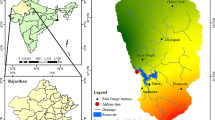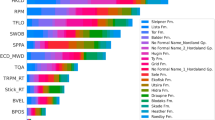Abstract
Due to the low precision in the prediction of foundation pit settlement of the traditional grey Verhulst model, the optimized discrete grey Verhulst model was selected as the preferred method in settlement prediction. In this work, a combination forecasting model was proposed based on the optimized grey discrete Verhulst model and BP neural network to better predict the foundation pit settlement. For application of the proposed models, the settlement of the foundation pit of a building in Longcheng Industrial Park in Shenzhen, China was predicted. The optimized discrete grey Verhulst model was established on reciprocal transformation of the original data sequence by discretization method. In the modified forecasting model, the predicted result of the optimized grey discrete Verhulst model was used as the input sample value of the BP neural network model and the measured value was used as the target sample value of the neural network model. Furthermore, the neural network was trained to target accuracy and made predict. The maximum number of epochs was 5 × 105. The target error of training is set as 1E−6. The prediction results of these grey models were compared with the prediction results of Kalman filter model. And the two-way verification was carried out to verify that these grey models were suitable for the settlement prediction of the foundation pit. The predicted results of optimized grey discrete Verhulst–BP neural network model display that the average relative errors and mean square errors of the settlement predicted value of two monitoring points CJ12 and CJ23 were 0.0967%, 0.0002 and 0.0795%, 0.00006, respectively. The results revealed that the optimized grey discrete Verhulst–BP neural network model combined the advantages of the two models to achieve complementary advantages, which has higher prediction accuracy and stability. Comparison between the calculated results and the measured ones indicate that the proposed model could satisfactorily describe the settlement monitoring projects.











Similar content being viewed by others
References
Acikgoz S, Soga K, Woodhams J (2017) Evaluation of the response of a vaulted masonry structure to differential settlements using point cloud data and limit analyses. Constr Build Mater 150:916–931
Ahangari K, Moeinossadat SR, Behnia D (2015) Estimation of tunnelling-induced settlement by modern intelligent methods. Soils Found 55(4):737–748
Azadi M, Pourakbar S, Kashfi A (2013) Assessment of optimum settlement of structure adjacent urban tunnel by using neural network methods. Tunn Undergr Sp Technol 37(2):1–9
Baziar MH, Azizkandi AS, Kashkooli A (2015) Prediction of pile settlement based on cone penetration test results: an ANN approach. KSCE J Civ Eng 19(1):98–106
Brown RG, Hwang PYC (1992) Introduction to random signals and applied Kalman filtering. Wiley, New York, pp 141–143
Cheng L, Rafig A, Tomás Fernández-Steeger (2016) Kalman filters in geotechnical monitoring of ground subsidence using data from MEMS sensors. Sensors 16(7):1109
Cui ZD, Ren SX (2014) Prediction of long-term settlements of subway tunnel in the soft soil area. Nat Hazards 74(2):1007–1020
Dai WJ, Liu N, Rock S, Pan JB (2016) Dam deformation monitoring data analysis using space-time Kalman filter. ISPRS Int J Geo Inf 5(12):236
Ding S, Dang YG, Xu N, Chen D, Cui J (2015) The optimization of grey Verhulst model and its application. J grey Syst 27(2):1–12
Doherty JP, Gourvenec S, Gaone FM (2018) Insights from a shallow foundation load-settlement prediction exercise. Comput Geotech 93:269–279
Eid HT, Shehada AA (2015) Estimating the elastic settlement of piled foundations on rock. Int J Geomech 15(3):04014059
Erzin Y, Gul TO (2014) The use of neural networks for the prediction of the settlement of one-way footings on cohesionless soils based on standard penetration test. Neural Comput Appl 24(3–4):891–900
Freitag S, Cao BT, Ninic J, Meschke G (2017) Recurrent neural networks and proper orthogonal decomposition with interval data for real-time predictions of mechanised tunnelling processes. Comput Struct 207:258–273
Gao DJ (2002) Deep foundation pit engineering. China Machine Press, Beijing (in Chinese)
GB50021-2001, State Standard of the People’s Republic of China (2001) Code for investigation of engineering. China Planning Press, Beijing (in Chinese)
GB50497-2009, State Standard of the People’s Republic of China (2009) Technical code for monitoring of building foundation pit engineering. China Planning Press, Beijing (in Chinese)
Ghorbani A, Niavol MF (2017) Evaluation of induced settlements of piled rafts in the coupled static-dynamic loads using neural networks and evolutionary polynomial regression. Appl Comput Intell Soft Comput. https://doi.org/10.1155/2017/7487438
Gong XN (1999) Design and construction manual for deep foundation pit engineering. China Architecture and Building Press, Beijing (in Chinese)
Gorsevski PV, Jankowski P (2010) An optimized solution of multi-criteria evaluation analysis of landslide susceptibility using fuzzy sets and Kalman filter. Comput Geosci 36(8):1005–1020
Grewal MS, Andrews AP (2001) Kalman filtering: theory and practice using MATLAB. Wiley, New York, pp 14–17
Guo XJ, Liu SF, Wu LF, Gao YB, Yang YJ (2015) A multi-variable grey model with a self-memory component and its application on engineering prediction. Eng Appl Artif Intell 42:82–93
Han LQ (2007) Artificial neural network theory, design and application, 2nd edn. Chemical Industry Press, Beijing
Harvey AC (1990) Forecasting, structural time series models and the Kalman filter. Cambridge University Press, Cambridge
Hataf N, Soleimanbeigi A (2006) Prediction of settlement of shallow foundations on reinforced soils using neural networks. Geosynth Int 13(6):161–170
He Y, Li BB, Zhang KN, Li Z, Chen YG, Ye WM (2019) Experimental and numerical study on heavy metal contaminant migration and retention behavior of engineered barrier in tailings pond. Environ Pollut 252:1010–1018
Ince CD, Sahin M (2000) Real-time deformation monitoring with GPS and Kalman filter. Earth Planets Space 52(10):837–840
Ismail A, Jeng DS (2011) Modelling load-settlement behaviour of piles using high-order neural network (HON-PILE model). Eng Appl Artif Intell 24(5):813–821
Kalman RE (1960) A new approach to linear filtering and prediction problems. J Fluids Eng 82:35–45
Kim YS, Kim BT (2008) Prediction of relative crest settlement of concrete-faced rockfill dams analyzed using an artificial neural network model. Comput Geotech 35(3):313–322
Kurnaz TF, Dagdeviren U, Yildiz M, Ozkan O (2016) Prediction of compressibility parameters of the soils using artificial neural network. Springerplus 5(1):1801
Leu SS, Lo HC (2004) Neural-network-based regression model of ground surface settlement induced by deep excavation. Autom Constr 13(3):279–289
Li L, Zhang M, Katzenstein K (2017) Calibration of a land subsidence model using InSAR data via the ensemble Kalman filter. Ground Water 55(6):871–878
Liu JH, Hou XY (1997) Excavation engineering handbook. China Architecture and Building Press, Beijing (in Chinese)
Liu SF, Lin Y (2011) Grey systems theory and application. Springer, Berlin
Liu SF, Yang YJ, Wu LF (2014) Grey information theory and practical application, 7th edn. Science Press, Beijing
Mei GX, Zai JM, Zhao WB, Yin JH (2005) Proof and application of s-shape settlement-time curve for linear or nearly linear loadings. Chin Civ Eng J 38(6):69–72
Miao SJ, Hao X, Guo XL, Wang ZM, Liang MC (2017) Displacement and landslide forecast based on an improved version of Saito’s method together with the Verhulst-grey model. Arabian J Geosci 10(3):53
Miškinis P, Vasiliauskienė V (2017) The analytical solutions of the harvesting Verhulst’s evolution equation. Ecol Model 360:189–193
Mohamed A, Shahin M (2014) Load-settlement modeling of axially loaded drilled shafts using CPT-based recurrent neural networks. Int J Geomech 14(6):06014012
Nejad FP, Jaksa MB (2017) Load-settlement behavior modeling of single piles using artificial neural networks and CPT data. Comput Geotech 89:9–21
Niu JT, Zhou B, Peng Y, Wei B (2012) Application of improved metabolic GM model in analyzing settlement of earth-rock dam in the period of construction. Proced Earth Planet Sci 5(8):213–217
Ocak I, Seker SE (2013) Calculation of surface settlements caused by EPBM tunneling using artificial neural network, SVM, and Gaussian processes. Environ Earth Sci 70(3):1263–1276
Rajabi M, Rahmannejad R, Rezaei M, Ganjalipour K (2017) Evaluation of the maximum horizontal displacement around the power station caverns using artificial neural network. Tunn Undergr Sp Technol 64:51–60
Su JZ, Yong X, Xu YL, Zhao X, Zhang QL (2014) Settlement monitoring of a supertall building using the Kalman filtering technique and forward construction stage analysis. Adv Struct Eng 17(6):881–893
Tarawneh B, Imam R (2014) Regression versus artificial neural networks: predicting pile setup from empirical data. KSCE J Civ Eng 18(4):1018–1027
Wang XQ, Qi L, Chen C, Tang JF, Jiang M (2014) Grey system theory based prediction for topic trend on internet. Eng Appl Artif Intell 29(3):191–200
Welch G, Bishop G (1995) An introduction to the Kalman filter. University of North Carolina, Chapel Hill
Willner D, Chang CB, Dunn KP (1976) Kalman filter configurations for multiple radar systems. NASA, Washington, DC
Wilun Z (1972) Soil mechanics in foundation engineering. Theory and practice. Wiley, New York
Xu C, Yue DJ, Deng CF (2012) Hybrid GA/SIMPLS as alternative regression model in dam deformation analysis. Eng Appl Artif Intell 25(3):468–475
Yang Y, He H, Xu G (2001) Adaptively robust filtering for kinematic geodetic positioning. J Geod 75(2–3):109–116
Zhang Y (2012) Improved grey derivative of grey Verhulst model and its application. Int J Comput Sci Issues 9(6):443–448
Zhang L, Wu XG, Ji WY, Abourizk SM (2016) Intelligent approach to estimation of tunnel-induced ground settlement using wavelet packet and support vector machines. J Comput Civ Eng 31(2):04016053
Zhang C, Peng ZB, Peng WX (2017) Application of optimized grey discrete Verhulst model in settlement prediction of foundation pit. J Cent South Univ 48(11):3030–3036
Zhao ZG, Ying HQ (2000) Concise handbook for design and construction of deep foundation pit engineering. China Architecture and Building Press, Beijing (in Chinese)
Acknowledgements
The authors would like to express their gratitude to the National Natural Science Foundation of China (41572269 and 41807253), and the Fundamental Research Funds for the Central Universities of Central South University (2018zzts202).
Author information
Authors and Affiliations
Corresponding author
Additional information
Publisher's Note
Springer Nature remains neutral with regard to jurisdictional claims in published maps and institutional affiliations.
Rights and permissions
About this article
Cite this article
Zhang, C., Li, Jz. & HE, Y. Application of optimized grey discrete Verhulst–BP neural network model in settlement prediction of foundation pit. Environ Earth Sci 78, 441 (2019). https://doi.org/10.1007/s12665-019-8458-y
Received:
Accepted:
Published:
DOI: https://doi.org/10.1007/s12665-019-8458-y




